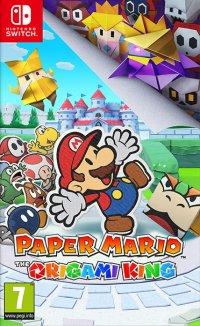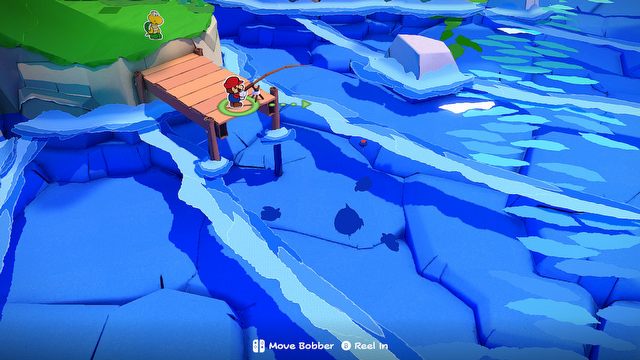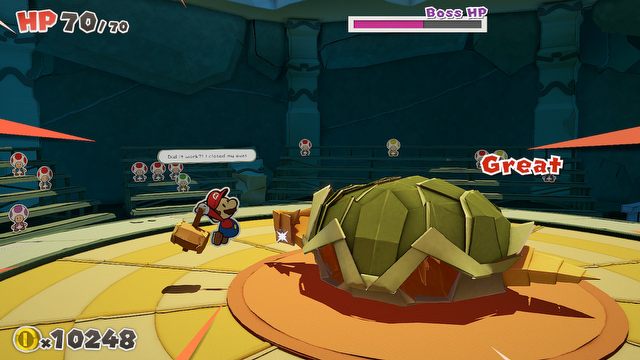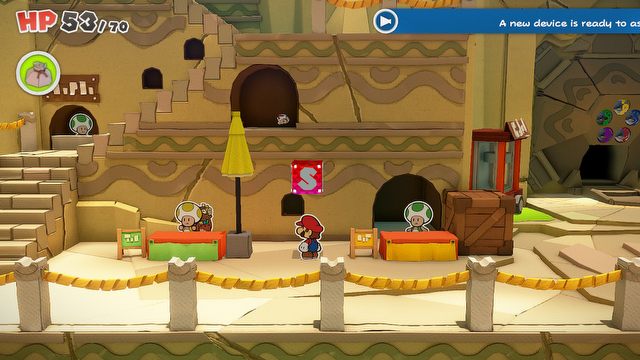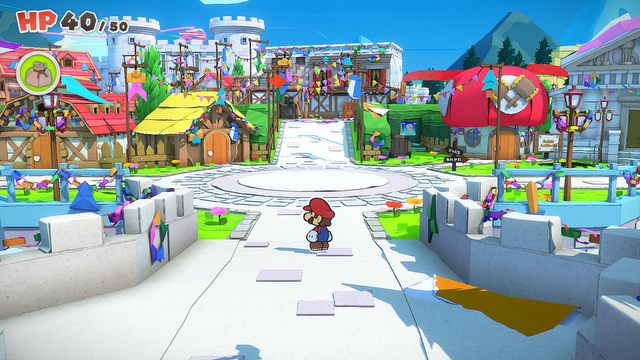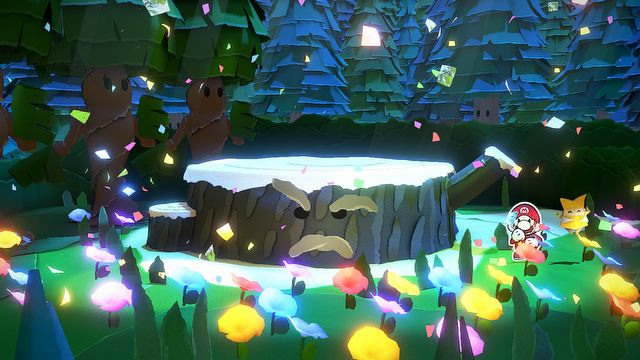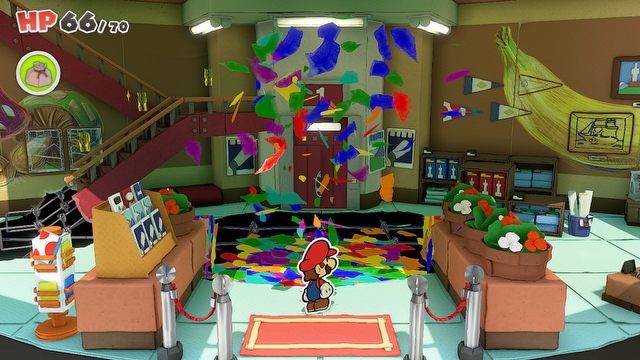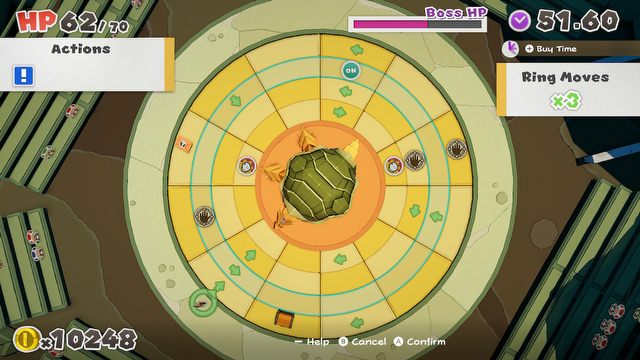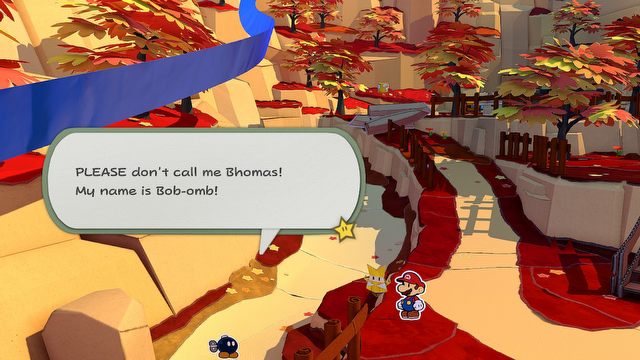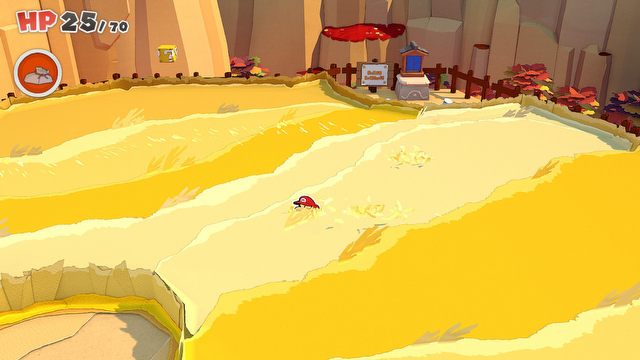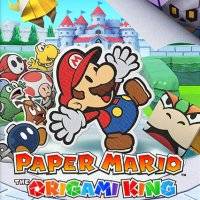Nintendo Delivers Once Again! – Paper Mario: The Origami King Review
The new Paper Mario is a very lightweight RPG and a lot of humour, colour and flat paper creatures turned by the title king into ominous origami versions. And of course Mario and a certain princess to save.
The review is based on the Switch version.

- colorful, beautiful and diversified visuals;
- unique combat mechanics;
- different mechanics for great boss fights;
- plenty of hidden Toads serving as collectibles;
- lots of arcade elements;
- fantastic sense of humor.
- at times, it has too much talking and pulls players away from the fun every few seconds;
- battles against enemies can be tedious and repetitive.
If I had a child or a younger sibling aged 10 or 12, I would watch them play Paper Mario: The Origami King. They would run around the colorful world, filling holes with equally variegated confetti and talking to the dwellers of the Mushroom Kingdom. However, before every turn-based and time-limited fight, which force players to make quick decisions, the kid would probably pass me the controller in order to get rid of the nasty creatures.
The problem is that I neither have any offspring nor a younger sibling, so I was forced to do all these "things in-between" by myself. I finally came to realize that I have no idea who may represent the target audience of the new Mario. Usually the titles of this franchise have worked as fantastic casual games for different types of players and I had a great time while playing them. However, this time I got the impression that despite the simple mechanics of the combat system, some of the later battles may be quite challenging for twelve-year-olds. Or maybe I just underestimate the abilities of teenagers? Although Paper Mario: The Origami King is definitely an excellent game that will appeal to fans' tastes, I got a little tired with it.
Paper stories
A man named King Olly turns the flat inhabitants of the mushroom world into three-dimensional origami creatures made of paper, making them aggressive as well as cold and grumpy. That's why Princess Peach throws Mario and Luigi, who arrived at the local fair, straight into the lowest dungeon of the castle. As usual, "fearless" Luigi rides his go-kart to search for help, while Mario, accompanied by a woman named Olivia, has to visit several different locations in order to reach the paper castle wrapped in rainbow-hued ribbon. To make things worse, the latter has even flown to another location. Our task is to get rid of these ribbons, which will, once and for all, remove the danger and restore order to the kingdom which is drowning in chaos.
The new Paper Mario has no ambition to become the next part of The Thousand Year Door. Origami King is rather an adventure arcade game with minor RPG features. In other words, we can consider it as an RPG, but it won’t discourage players who don’t like an overwhelming number of statistics. During the game, I couldn't shake the feeling that I was in contact with a very distant cousin of Darkest Dungeon (a really distant one, which is barely visible on the horizon in a sunny weather that provides many kilometers of visibility) and a variation on Paper Mario: Color Splash, in which paint can was replaced with a bag of colored paper strips.
Paper world
The game features different types of weapons that can be used against enemies during the adventure and numerous aids that will allow you to survive the battle a bit longer. Mario's primary weapons are his boots that allow him to jump over opponents' heads and a wooden hammer, which may effectively knock out all stupid ideas of their heads. Improved versions of these, as well as brand new tools, can be bought from vendors located in towns set across particular lands. Each of the additional weapons gets destroyed after a fairly short period of time, thus frequent store visits will quickly become a habit. I have to admit that I’m not in favor of this type of solutions in video games because their primary purpose is to artificially lengthen the playthrough. However, I will make my own argument against the aforementioned statement – nothing prevents you from purchasing a larger stock pile of arms during a single visit. Also, there is a tactical mindset in that, because the weapons can be destroyed in combat and if we don’t have a suitable replacement, we will only be left with a wooden hammer and slippers, which only serve their purpose for the first two or three hours.
But before these and other facilities open their doors, we must find the hidden Toads. There are dozens of them, often hidden in various strange places, and they play the role of somewhat unusual collectibles in the game. Unusual, because in the course of a fight we have access to their community and by bribing them we can use their help to "sort out" the board in order to wipe out all opponents more easily.
Glossy chalk paper
This brings us to the creme de la creme of Paper Mario, namely the combat mechanics. It’s a turn-based system, but the countdown clock does not allow us to think too long about the next move. However, it is extremely original and I do not recall encountering a similar concept before. In short, it looks like enemies are spread around the main character on several surrounding rings, which were divided further into sectors. Our job is to manipulate these rings in such a way as to position the opponents in one line, which provides a bonus to the attack, but at the same time make the weapon as effective as possible.
This unique feature may resemble a puzzle mini-game, which I liked very much at the beginning of the game. One drawback may be the strict time limit, but with coins, we can prolong it a little bit. In fact, the only problem I struggled with during the game was the creeping boredom and combat repetitiveness. At least until new types of enemies were introduced.
Ingeniously designed bosses pose a greater challenge. In this case, the situation is flipped upside-down and it is the boss who is at the center of the circles made up of the rings. By manipulating them with different types of pictograms describing the direction of motion and triggering some additional effects, players must reach the center and attack the boss's weak point. This role reversal really appealed to me. All the more so because the bosses are trailblazing and fighting each one of them is an unforgettable experience. How about fighting a box of crayons? I'm writing about it right now!
Recycled newsprint
I was a little less fond of exploration. Yes, worlds are very pleasant in visual terms, often requiring a little dexterity – for example, when we fight huge paper-mache goombs or squeeze through narrow corridors between flame-throwing devices. On the other hand, I was incredibly annoyed by the constant meddling of Olivia, the sister of evil King Olly. There were locations where we literally lost control of Mario every five seconds, because Olivia had to explain something or throw some kind of joke, often breaking the fourth wall. To some extent, I tolerate this kind of game behavior, but The Origami King has so much talking that you want to skip all the dialogues in order to get to the proper gameplay as soon as possible.
I'm also not convinced by walking around and filling up the holes of the fungus world with colorful cardboard pieces. It's a boring, clogging tool that is being excessively used by developers to often restrict us from reaching other locations, forcing us to complete a mini-game or defeat another horde of opponents.
Paperweight – for Nintendo
Although I liked the game, mainly due to its brand new combat mechanics and the overall world design, I did not feel I was the appropriate target audience. Paper Mario: The Origami King has everything a high-budget game from Nintendo should have with a mustachioed plumber in the lead role – top quality workmanship, well-developed mechanics, as well as colorful and vibrant locations. The key issue is the fact that at the same time game designers have failed to create a casual game, that is, a title capable of entertaining all generations of players, as I have mentioned it earlier at the beginning of this review. So far, I was always crazy about the vast majority of games in the Mario series, but this time I didn't feel that compatibility with the designers of the Japanese studio. Shame. I'm sure there will be many more opportunities to improve our relationship.
ABOUT THE AUTHOR:
Paper Mario has a special place in my heart mainly thanks to the iconic The Thousand Year Door for Nintendo GameCube, but I had fun with both the parts prepared for Wii and Wii U. It took me about 30 hours to complete the Origami King. I didn't try to focus too much on looking for Toads.
Paper Mario: The Origami King
Nintendo Delivers Once Again! – Paper Mario: The Origami King Review
The new Paper Mario is a very lightweight RPG and a lot of humour, colour and flat paper creatures turned by the title king into ominous origami versions. And of course Mario and a certain princess to save.
